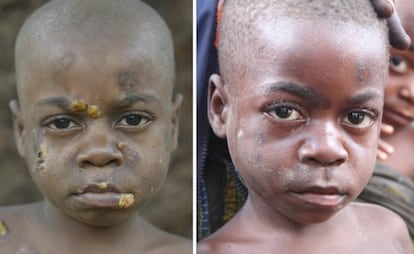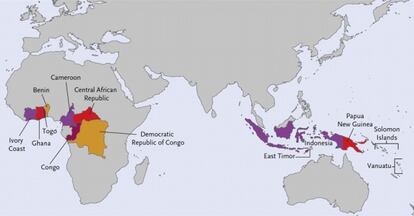The young Spanish doctor working to eradicate a tropical infection
Oriol Mitjà believes simple antibiotics should be enough to wipe out yaws by 2020

In 2010, soon after finishing his medical studies, in which he specialized in tropical medicine, Oriol Mitjà went to work on the remote island of Lihir, in Papua New Guinea. One of the first patients the 29-year-old saw was a boy with symptoms he had never seen or read about before: a red ulcer on his arm the size of a two-euro coin. When he asked a local doctor what it might be, he was told, “yaws.”
Yaws, also known as pian, is a chronic bacterial infection related to syphilis, although it is not spread by sexual contact. It affects around half a million people in poor communities in warm, humid tropical regions of Africa, Asia, Latin America and the Western Pacific. Around three quarters of those with the disease are aged under 15.
Yaws is transmitted primarily through skin contact with an infected person. A single skin lesion develops at the point of entry of the bacterium after two to four weeks. If left untreated, multiple lesions appear all over the body. Although rarely fatal, yaws can lead to chronic disfigurement and disability. Overcrowding, poor personal hygiene and inadequate sanitation facilitate the spread of the disease.
Yaws affects around half a million people in tropical regions, around three quarters of them under 15
In the West, the disease is unknown, and has largely been forgotten. In 1952, when there were around 50 million people with the condition, the World Health Organization (WHO) and UNICEF set out to eradicate yaws through mass penicillin injection campaigns in 46 countries. Twelve years later, the number of clinical cases had fallen by 95 percent. But since then, in the absence of further eradication campaigns, it has gradually returned to the world’s poorest corners.
Mitjà, recognizing that yaws can be beaten with simple antibiotics, decided to take action and contacted Quique Bassat of the Barcelona-based Global Health Institute. The project needed a simpler treatment than a penicillin injection, which requires trained medical staff. In 2012, they announced the results of a study involving 250 children with the disease, published in The Lancet: using a single dose of azithromycin, a powerful antibiotic used in wealthy countries to treat bronchitis, the children had been cured.
Encouraged by Mitjà’s success, the WHO decided to try to eradicate yaws once and for all by 2020. This would mean no reported cases from 2017. Mitjá’s approach would need to be verified on a large scale.
A study just published by The New England Journal of Medicine shows the results of a mass treatment campaign carried out on most of the 16,000 inhabitants of Lihir. In just one year, between 2013 and 2014, the number of yaws cases fell by almost 90 percent. The presence of the disease among the population fell from 2.4 percent to 0.3 percent. The study will continue there until no more yaws cases are reported.

“Our results show that the strategy should eradicate the disease by 2020,” says Mitjà by phone from Papua New Guinea, where he runs the Lihir Medical Center. Yaws has already disappeared from his hospital. When he arrived in 2010, he began visiting schools in the area to get an idea of the spread of the disease he had just come across. Classroom by classroom, he asked teachers to request that pupils with ulcers on their arms stand up. “Around half the class would stand,” he says. Other children, their faces disfigured by sores, were in such a poor state of health that they no longer attended school
“The main difficulty in eradicating the illness is getting to the more remote areas,” says Mitjà. On Lihir, his teams managed to distribute tablets to 84 percent of the population. In other places, that figure would be very hard to reach. In September 2012, Doctors Without Borders tried Mitjà’s approach in one of the most remote areas of the planet: the jungles of northern Congo, which involved long journeys in four-wheel-drive vehicles and canoes, and slogging it through forest trails to reach Aka pygmy hunter-gatherer communities.
Around 10 percent of the children in these isolated areas had yaws ulcers. Many of them were reluctant to take the azithromycin, never having seen Western pharmaceuticals before. But thanks to an epic effort, the NGO was able to administer the antibiotic to 17,500 people. The problem was that the Aka people are nomadic, and have continued to bring yaws back into communities that had been treated.
“The fragility of health systems in these countries is the Achilles’ heel of any campaign like this,” says Quique Bassat, who is now running a health research center in Manhiça, Mozambique, where he investigates diseases such as malaria, AIDS, and tuberculosis. But Bassat remains optimistic, as long as the political will is there to tackle health problems. “The WHO is now obliged to work to eradicate yaws,” he says.

Among the challenges the WHO faces is getting the 13 countries still affected by yaws to work together, given that a synchronized campaign will be most effective. This means coordinating the health authorities in countries such as Ivory Coast, Central African Republic, Republic of the Congo, Democratic Republic of the Congo, East Timor, and Papua New Guinea.
Another major challenge is finding the funding, even though the treatment is relatively cheap. On Lihir, each tablet of azithromycin cost just 15 euro cents, thanks to a deal with an Indian pharmaceutical company. The human resources required to distribute the tablets were paid for by Australian mining company Newcrest, which owns a huge gold mine located in an extinct volcano crater. It is one of the world’s largest gold deposits, producing around 280,000 kilograms of gold since 1997. That said it has provided little benefit to the 16,000 inhabitants of Lihir, who mostly continue to live in poverty.
To fund the global yaws eradication campaign, the World Health Organization is negotiating with US pharmaceutical company Pfizer, which refused to donate azithromycin for the campaign on Lihir. The company, which reported a net profit of more than €8 billion in 2014, has donated more than 225 million azithromycin doses for an international campaign against trachoma, a bacterial disease that causes blindness, and affects around one million people a year around the world. “Pfizer was waiting to see the results of the program on Lihir to decide whether it will take part in the global campaign,” says Mitjá. If all goes to plan, by the end of the decade, thanks to a young doctor from Barcelona, yaws will be only the second human disease to be eradicated from the planet after smallpox.
Tu suscripción se está usando en otro dispositivo
¿Quieres añadir otro usuario a tu suscripción?
Si continúas leyendo en este dispositivo, no se podrá leer en el otro.
FlechaTu suscripción se está usando en otro dispositivo y solo puedes acceder a EL PAÍS desde un dispositivo a la vez.
Si quieres compartir tu cuenta, cambia tu suscripción a la modalidad Premium, así podrás añadir otro usuario. Cada uno accederá con su propia cuenta de email, lo que os permitirá personalizar vuestra experiencia en EL PAÍS.
¿Tienes una suscripción de empresa? Accede aquí para contratar más cuentas.
En el caso de no saber quién está usando tu cuenta, te recomendamos cambiar tu contraseña aquí.
Si decides continuar compartiendo tu cuenta, este mensaje se mostrará en tu dispositivo y en el de la otra persona que está usando tu cuenta de forma indefinida, afectando a tu experiencia de lectura. Puedes consultar aquí los términos y condiciones de la suscripción digital.
Últimas noticias
Reinhard Genzel, Nobel laureate in physics: ‘One-minute videos will never give you the truth’
Pinochet’s victims grapple with José Antonio Kast’s rise in Chile
How Japan is trying to avert ‘digital defeat’
The complicated life of Francesca Albanese: A rising figure in Italy but barred from every bank by Trump’s sanctions
Most viewed
- Pablo Escobar’s hippos: A serious environmental problem, 40 years on
- Why we lost the habit of sleeping in two segments and how that changed our sense of time
- Charles Dubouloz, mountaineering star, retires at 36 with a farewell tour inspired by Walter Bonatti
- Trump’s obsession with putting his name on everything is unprecedented in the United States
- The Florida Keys tourist paradise is besieged by immigration agents: ‘We’ve never seen anything like this’









































